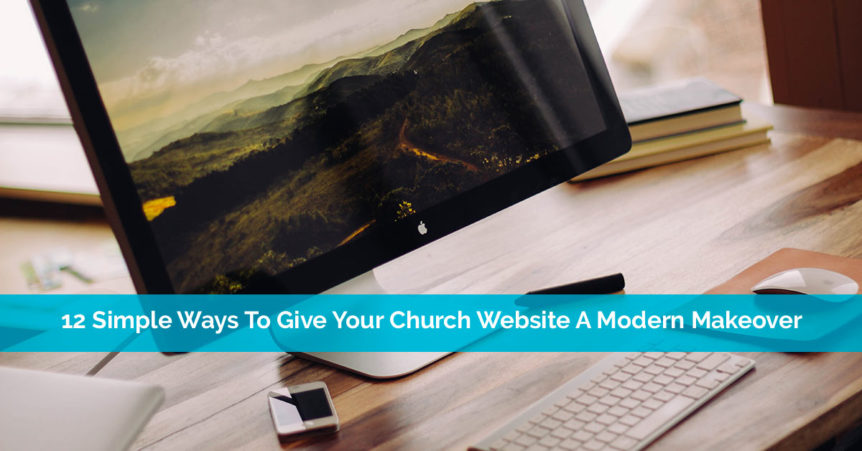Unlike classic TV shows, a classic website isn’t nearly as endearing or engaging. In fact, it could easily turn visitors away.
When it comes to church web design, modern is the way to go. Ideally, you need a church website makeover every few years.
While you don’t have to get a completely new site, adding some fresh elements drastically changes the look and feel. This makes a great first impression and keeps visitors coming back.
1. Opt For Minimalism
You’ve likely heard all about the minimalist trend when it comes to clearing away clutter in your home and life. The minimalism web design trend was actually popular well before that. However, it’s still a sign of a modern church website.
Now, it’s important to note that minimalism doesn’t mean you shouldn’t have plenty of content on your site. However, all of it should matter. Adding images and text just to fill in space makes your site look cluttered and dated.
The cleaner the site, the more attractive it is to visitors. Plus, it’s easier to see the most important elements, such as your church’s location, service times and latest online sermons.

Smashing Magazine goes in-depth into the elements of minimalism and how to use them effectively. Mockplus showcases great examples of minimalist homepages to give you an idea of how they should look.
We’ll talk more about white space in a moment, but a large part of minimalism is using white space to your advantage and using larger, bolder elements to grab attention.
2. Replace Stock Photos
One of the simplest ways to get a quick church website makeover is to replace some of your stock photos. Do you have just a generic picture of a church or a smiling group of people on your church’s homepage?
While it may not seem like a big deal, if you’re using stock photos, your visitors have probably seem them before on other sites. That smiling group of people might be the homepage photo for a landscaping business or team building company.
You want your church’s site to seem real and stand out from the rest. Real images perform better and give visitors more insight into your church’s personality. It’s also a great way to make visitors who actually visit your church feel more at ease since they’ve already seen the church and some of your members online.
First of all, make sure you get written permission from your members to use their photos online. Some may not be comfortable with it and that’s fine. You can still use stock photos, but it’s best to save those for your blog posts, though if you can use real photos on those sometimes, by all means, do so.
3. Use A New Layout
If you want a church website makeover that’s more drastic, use a new layout. Usually, this means rearranging your content so it’s easier for visitors to interact with and more aesthetically pleasing.
When it comes to website layouts, you have numerous options to choose from. Some of the most common ones in modern web design include:
- Single-column – Often used in minimalism
- Split-screen
- Three boxes – Creates a hierarchy
- Full-screen image – Great for homepages
- Fixed sidebar
Amelia showcases great examples of all of these layouts and more. This shows you what they look like and whether they’re a good fit for your church.
Of course, you can always have a custom layout created. While layouts are typically in a grid format, some modern websites have a more fluid, freestyle layout. This works well for a more relaxed church.
4. Add Social Elements
One of the easiest ways to date your church website is to not have any social media elements. Even if your church isn’t on social media, you need to have social sharing features for your sermons and blog posts.
As of early 2019, there were 3.484 billion active social media users worldwide. Why wouldn’t you make it easy for billions to share your content on their favorite social media platforms?
This is incredibly easy to implement and helps boost the popularity of your church website. You don’t have to offer sharing options for every social network out there, but at least offer three or four options, such as Facebook, Twitter and Instagram.
If your church is on social media, ensure there are obvious links to follow your church on your chosen platform(s). Often, these are placed in the footer, the About Us page or as a menu item called “Social Media” or “Follow Us.”
5. Utilize White Space
White space, also known as negative space, is one of the most effective web design techniques. It may sound simple, but don’t underestimate it. Sometimes, a person will chose a website when the only difference is white space.
So, what makes it so powerful? First, it makes every element on the page stand out more. Imagine it like this. You have five photos. You could place them side by side with no space between them. While that works, it’s harder to distinguish one from the other.

Now, ad a strip of white space between each photo. Suddenly, you’re able to distinguish individual photos and see details you never noticed before.
A great example is Google’s homepage. Before Google was the go-to search engine, most search engines yielded similar results, but Google quickly took the lead. The simple design with ample white space made it seem more friendly and easier to use.
If you want your site visitors to be able to focus on the content, space out elements. Less really is more. The good news is there are quite a few ways to use white space. The Interaction Design Foundation explains different types of white space and how to use each effectively for a modern church website makeover.
When you’re incorporating more white space, this is also a great time to eliminate elements you don’t need. Think of it as spring cleaning your church’s website.
6. Use Animations & Video
Animations aren’t just for cartoons. Instead, they add movement to your site and make certain elements seem to jump off the screen, aka visitors notice them more.
One thing to note before you attempt this is to limit animations. Too much creates chaos.
Sometimes, animations are as simple as a hover effect or transitioning images on your homepage. They don’t have to be complex. UX Planet describes some of the top animation styles and provides examples of them in action.
Of course, videos are just as eye-catching. Plus, they allow you to add more content without taking up much space. For instance, on your Giving page, you might have a video that explains how funds are used and shows interviews, before/after images, ministries in action and more. This could take thousands of words to explain or just a 5-10 minute video.
For a more modern church website makeover, try to incorporate at least a few animations and replace bulky text sections with videos. After all,
- People watch over 500 million hours of video on YouTube a day
- A third of all online activity is video watching
- 95% of a message is retained in video form versus just 10% in text form
- Visitors stay on a site 88% longer if there is an engaging video
Visuals are highly engaging, so incorporate them to give your church’s site a modern look and a competitive edge.
7. Simplify Navigation
Navigation can make or break even the best sites out there. You’ve probably left websites yourself when the navigation was clunky or just impossible to figure out.

If your visitors have to search for your menus or the menus are difficult to use, they will leave your site. Obviously, you want visitors to stay and see what your church has to offer. This means a church website makeover, at least when it comes to navigation.
The single most important thing to remember is to simplify navigation. If you have a menu with several levels of options, it’s too complicated, especially on mobile devices.
One of the most popular options is the hamburger menu. This is what is commonly used in mobile apps to save on space. Since it’s so widely used, visitors have become accustomed to it. When visitors click the three little stacked lines, they’re presented with a large menu that’s easy to see and interact with.
However, hamburger menus also represent an extra click to access your menu. Some great alternatives include:
- Fixed side menus
- Slide-out side menus
- Header menus – Avoid lengthy sub-options and nested menus
- Footer menus – Great addition to header menus for easier access
The key takeaway is ease of use. The fewer clicks or taps, the happier the visitor.
8. Update Your Fonts
You may not think much about the fonts on your church website, but your visitors do notice. Changing them is a subtle, yet effective way to modernize your site.
Sure, Times New Roman and Arial are nice, but they’re also better suited for a term paper than your church’s site. Using the right font can even increase the credibility of your site. While visitors may not be able to pinpoint
Simply using a few different fonts makes your entire website look different. Many sites are turning to Google Fonts for a more modern look. They’re free to use and there’s plenty to pick from. Pairing a few together helps to better engage visitors and keep them around longer.
9. Get Rid Of What Users Hate
This might sound insanely general or simple, but it’s effective. Why leave elements on your site that users hate? Maybe you have a pop-up menu on a certain page that increases your bounce rate. What about a floating menu that annoys visitors?
UX testing helps you to figure out what elements visitors like and what they don’t. A/B testing, heat mapping and even user feedback groups help you create a better version of your church’s site.

For churches on a budget, asking members or people in the community to test out your site and provide feedback is the most
10. Improve Page Loading Speeds
Page loading speeds might not have anything to do with how your site looks, but it will make a difference in how visitors perceive your site. After all, if visitors leave before they even see a page, it won’t matter how your church website looks.
Give your church’s site a speed makeover. Some of the best ways to reduce page loading speeds is to:
- Reduce image sizes
- Keep script files near the bottom of your page
- Enable site compression
- Use browser caching
11. Make The Footer Useful
The footer isn’t just a place to throw a few links or some copyright information anymore. Instead, it’s a crucial part of your church website.
Think of your footer as a condensed website. You want to put your most important details here. Think about it like this. A visitor goes through a page and wants to know more or navigate to another page. They could scroll all the way back to the top or get everything they need at the bottom of the page (where they already are).
Use your footer to add a second menu, your church’s location, contact details, blog link, social media links and other relevant links.
12. Revamp Your Content
Outdated content is a surefire way to show visitors the age of your church website. For instance, if you’re using large blocks of text versus shorter paragraphs, it’ll seem like a site from the late 90s or early 2000s.
If it’s filled with keywords and difficult to read, visitors and search engines will see it as an outdated, spammy site.
You don’t want any of those scenarios. Instead, clean up old content. Get rid of anything that’s not useful to your visitors. Make it easier to read. Implement better organization, such as tags and categories.
Doing a content audit every year is an easy way to get a new church website makeover annually.
Not sure where to start? Try our free website analysis to learn more about how to improve your church website.




